The kind of long narrative of serialized TV can be wonderfully immersive, but here at 25YL we also recognize the value of a great standalone episode. Join us as we explore horror and sci-fi anthologies old and new, along with some other standout episodes of shows you love. This week, Rebecca Saunders explores another episode of The X-Files.
As we explore standalone episodes from horror and sci-fi anthologies, I will break down how The X-Files’ “Monster of the Week” episodes (separate from the show’s overarching mythology) often employed science fiction concepts that are grounded in scientific fact. This week, we’ll look at “Syzygy” (Season 3, Episode 13).
If you don’t recall, “Syzygy” is the episode where two homicidal teenager girls are bestowed psychokinetic powers by a planetary alignment. Throughout the episode, their town is convinced that Satanists are committing atrocities, and respectable townspeople are reduced to a frothing, witch-hunting mob. In our exploration of the scientific grounding of this episode, we will focus on the mysterious sociological phenomenon of collective behavior and the astronomical term ‘syzygy’. We will also look briefly at the pseudo-scientific concept of astrological influence. Hey, we want to believe, right?
Episode overview
“Syzygy” takes place in Comity, New Hampshire. In the opener, a group of high-schoolers is holding a eulogy for a friend who purportedly died at the hands of a Satanic cult. Notably, we are never privy to how the rumors attributing mysterious deaths to Satanic ritualism were first generated. Two girls, Terri Roberts and Margi Kleinjan, get a ride home from a jock, Jay “Boom” DeBoom (Ryan Reynolds). In the car, Terri and Margi convince the grieving jock that the cult members will sacrifice a blonde virgin, and intimate that they, as blonde virgins, would like to lose their virginity and their susceptibility to death by ritual sacrifice.
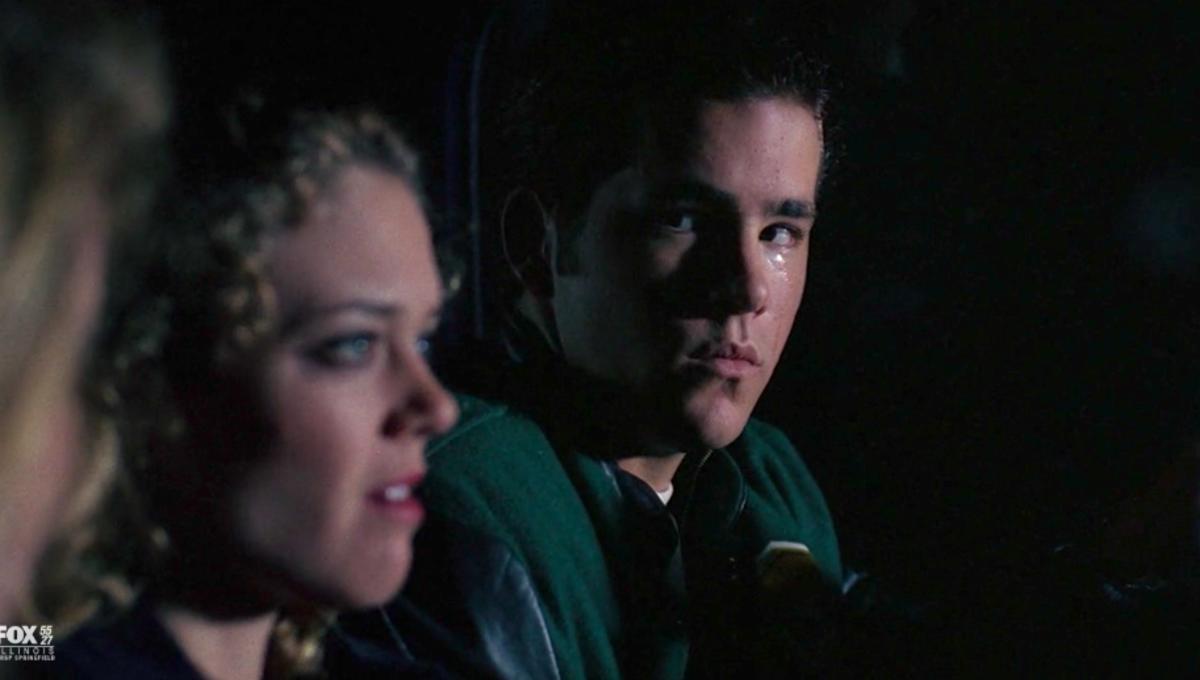
The next day, police find Boom hanging from a cliffside. Beyond the police’s view and at the beginning of the rope from which Boom is hanging, Terri and Margi sit laughing and playing “He loves me, he loves me not.” From the beginning of the episode, viewers are privy to the information that Terri and Margi are responsible for the “Satanic cult” killings. Terri and Margi’s homicidal tendencies are also closely linked to their teenaged whimsy.
Special Agents Fox Mulder (David Duchovny) and Dana Scully (Gillian Anderson) arrive in Comity after arguing about directions along the way. They meet local detective Angela White and visit Boom’s funeral. Scully is immediately skeptical of the attributions of deaths to Satanic cult killings. Bob Spitz, the high school principal, interrupts the funeral by engaging in an Inquisition-style rant about Satanic cults murdering children. Terri and Margi link hands, and suddenly Boom’s coffin spontaneously combusts.
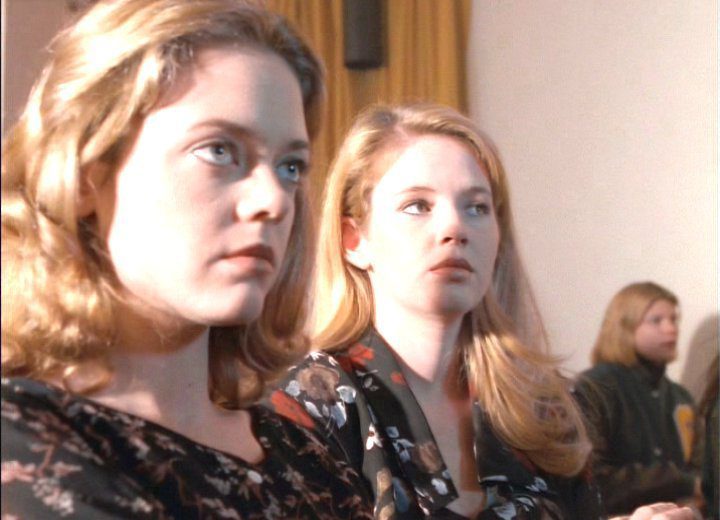
Scully and Mulder interrogate Terri and Margi separately because they were with Boom the night he died. The girls provide identical stories about a Satanic ceremony with ritual infanticide. Scully notes that their stories are clichéd urban legends and links belief in Satanic conspiracy to illogical paranoia. When examining Boom’s corpse, Mulder and Detective White find a burn mark in the shape of a horned beast (incidentally, the high school mascot in the town is a goat), but Scully says she cannot see it.
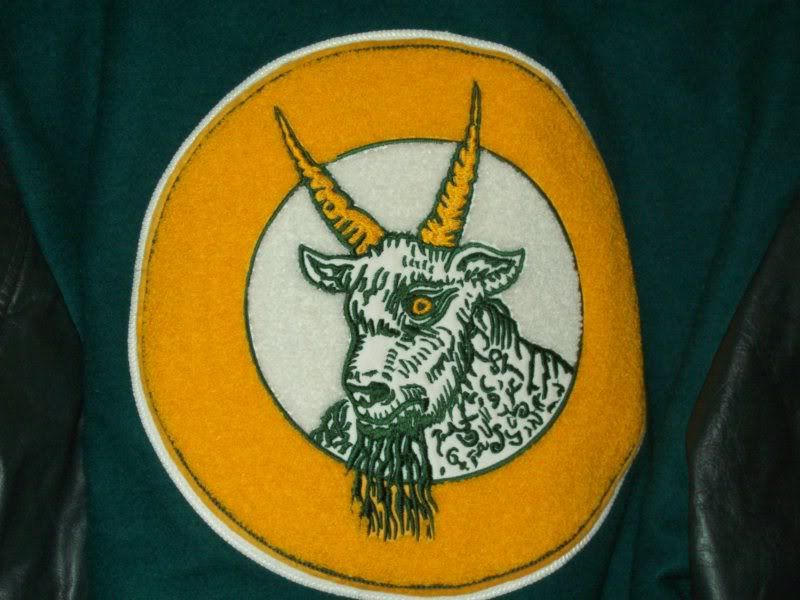
Mulder and Detective White visit local astrologer Madame Zirinka, who casually reveals that the town’s unusual behavior can be attributed to a rare planetary alignment of Mars, Uranus, and Mercury. At the same time, Terri and Margi kill another high-schooler who accidentally spills a table of drinks on them during basketball practice. Telekinetically, they cause the basketball to bounce beneath the bleachers and then close the bleachers on top of him when he retrieves the ball, killing him. Meanwhile, Scully voices her animosity toward Mulder and Detective White’s “simpatico.”
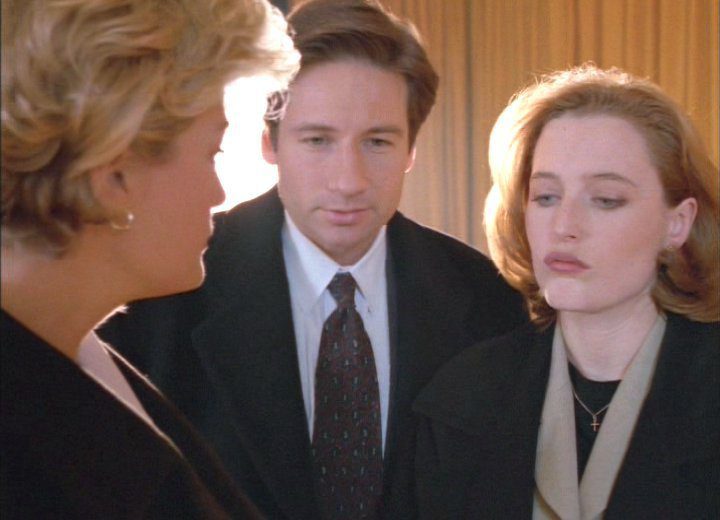
Next, we see a town mob taking matters into their own hands. They search for an alleged mass grave in the woods and find a bag of bones that is inscribed with the name of the local pediatrician. Spitz, the school principal, mistakenly assumes that the bones are a child’s skeletal remains. The angry mob bombards the doctor’s home, whereupon he claims that he sold the bag and is not responsible for its ghastly contents. Ultimately, the bones are found to belong to Terri’s dead dog, Mr. Tippy. Incidentally, Terri—one true culprit of the town’s mysterious murders—is linked directly to the object of the town’s suspicion, but she evades persecution.
Next, we find out that it is Terri and Margi’s joint birthday. At their birthday celebration, a girl named Brenda uses an Ouija board to find out who she will marry, and the planchette spells out Satan. Brenda, distraught, rushes to the bathroom to find Terri and Margi playing a round or two of “Bloody Mary.” They telekinetically lock Brenda in the bathroom and kill her with glass from the shattered mirror.
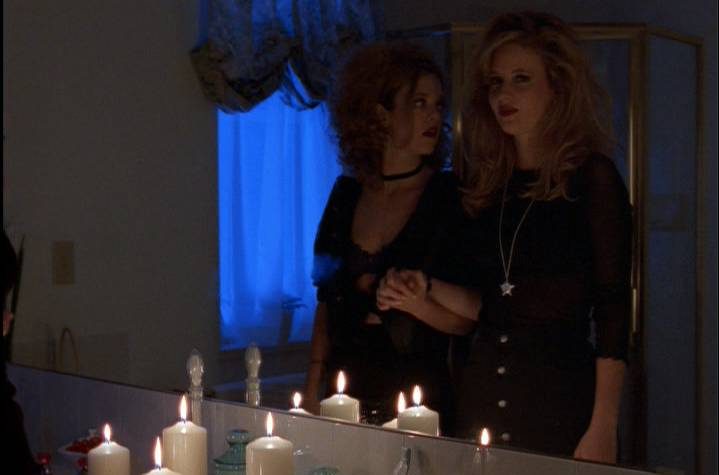
Elsewhere, people are still acting strangely. Detective White visits Mulder in his hotel room and comes on to him, but they are interrupted by Scully, who has come to report Brenda’s death. Terri and Margi come on to Scott, Brenda’s girlfriend, but he puts them off. Terri’s whimsical rage is provoked, but Margi still likes him and leaves Terri to follow him.
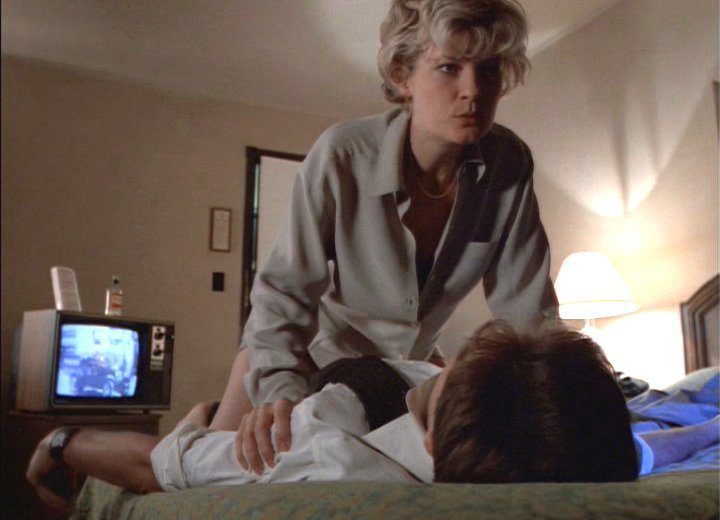
Mulder visits Madame Zirinka again. The astrologist reports that this planetary alignment occurs once every 84 years, and additional alignments will cause anyone born on January 12, 1979 (you guessed it—Margi and Terri’s birthdate) to have the weight of cosmic energy focused on them. Margi approaches Scott alone, but an enraged Terri also arrives. The two girls argue but accidentally kill Scott as they cause tools and other objects to fly about the room.
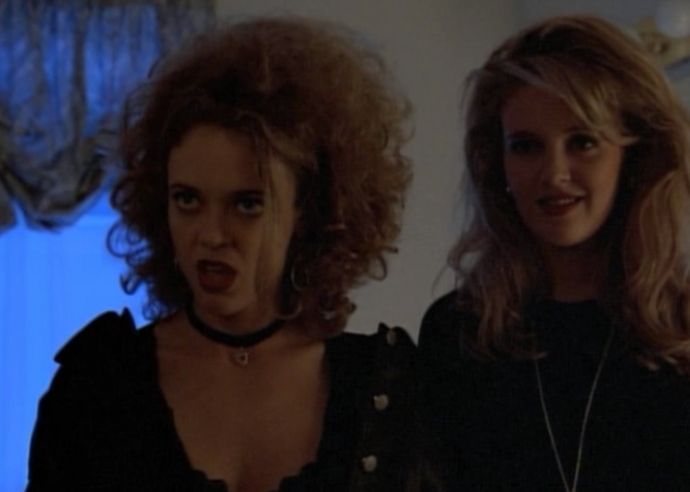
Now that there is a rupture in their friendship, the two girls implicate one another in Scott’s death. Margi reports Terri to Mulder, and Terri reports Margi to Scully. When Scully and Mulder see what is happening, they bring both girls to the police station. The building shakes and guns fire spontaneously. Mulder first separates the girls but then locks them in a cell together.
The building’s shaking intensifies until the clock strikes midnight and their powers magically cease. The two girls are now apparently docile, and they sob as they clutch one another tightly in a corner of the room. When the town mob and Detective White finally recognize that the seemingly innocent girls are the culprits, Principal Spitz declares that this was indeed the work of Satan, oblivious to the powerful energy of the cosmic alignment.
Collective behavior and the mob mentality
Now, the behavior of the townspeople in “Syzygy” may not seem like the spookiest factor of the episode, but it is the most disturbing. Although the Comity townspeople’s behavior seems to be a marginal factor in the episode, their actions in fact drive much of the action of the plot. Their hysteria is proven to be as dangerously volatile as Terri and Margi’s murderous impulses. Documented cases the world over prove that groups of people can be affected by misinformation which causes them to behave in erratic unison. Crowd behavior or collective behavior is unpredictable, unstable, and not well understood by sociologists.
The sociological definition of collective behavior includes three social phenomena: fads, mass hysteria, and riots. When a group of people form a mob, they cease to be a sociologically defined group and become a deviant mass of people with loose adherence to societal norms. The mob mentality is often destructive. It also can be referred to as mass hysteria, hysterical contagion, or herd mentality, and it is related to the phenomena of mass psychogenic illness and mass sociogenic illness.
Mass psychogenic illness, also known as epidemic hysteria, occurs when a group of people believes they are suffering from a viral physical condition but symptoms are exhibited unconsciously and have no corresponding physical etiology. In other words, people experience physical symptoms with no apparent physical cause. Examples of mass psychogenic illness include dancing manias of the Middle Ages, false anthrax alarms after the 2001 anthrax attacks, and the heartbreaking incidence of resignation syndrome (Swedish: Uppgivenhetssyndrom) among children in recent refugee families.
The phantom epidemics of mass psychogenic illness are not directly relevant to the collective behavior displayed by Comity townspeople in “Syzygy.” However, these examples serve to demonstrate the severe panic that mass hysteria can induce. If a loosely defined group of people can convince themselves that they are experiencing an epidemic to such a degree that they experience physical symptoms, then it probably doesn’t take much for, say, members of a small town to believe that Satanic ritualists are preying upon their children. Things become uniquely dangerous when an erratic group of misinformed people decides to act.
With “Syzygy,” Chris Carter may have been satirizing the mass hysteria surrounding allegations of daycare sexual abuse and Satanic sacrifice in the prolonged McMartin trial of the 1980s-1990s. During this time, journalists were slow to question and even hyped the Satanic ritual abuse allegations, despite the fact there were “no missing people, no bodies and, oh yeah, virtually no evidence to bolster the claims.” For your edification, you can check out this Listverse listicle on predominant cases of mass hysteria that features the daycare ritual abuse hysteria. If you want more, then take a look at Wikipedia’s more comprehensive list of mass hysteria cases that spans cases from the Middle Ages to the 2000s.
In general, social scientists believe that cases of mass hysteria are widely underreported. The psychosocial dangers of collective behavior and mass hysteria are obviously pronounced in the 21st century with the advent of digital media. In all, Scully was right to insist that the Comity townspeople’s hysteria over Satanic ritual abuse was the result of misinformation through urban legend and paranoia, whereas Mulder and Detective White entertained the possibility that the ritual abuse allegations were valid.
Notably, it is never disclosed in “Syzygy” where the rumors of Satanic ritual abuse originated, but we can assume that Terri and Margi themselves may have promulgated the mass hysteria to cover their impulsive crimes. Their engrossment in other urban legends such as “Bloody Mary” and their shaping of the Satanic ritual abuse narrative during police questioning suggests as much. However, Scully and other shrewd skeptics like her still scoff at the pseudo-scientific basis for the actual cause of Terri and Margi’s mass murders in “Syzygy”: astrological influence and psychokinetic abilities.
Syzygy, astrology, and prophecy: The pseudoscience of it all
If you really want to piss off someone who studies outer space for a living or even as a hobby, then mix up the terms “astronomy” and “astrology.” Astronomy is the natural science that studies celestial objects and phenomena using mathematics, physics, and chemistry to develop theories about the origin and evolution of stars and planetary bodies. Astrology is the metaphysical practice of divining information about human affairs and terrestrial events by studying the movements and relative positions of celestial objects. All the scientific information we have about our sun, solar system, galaxy, and the universe is the result of astronomic calculation. Your zodiac, natal birth chart, and horoscope fall in the astrological realm.
In any case, the term syzygy is relevant to both the science of astronomy and to the fringe science or pseudoscience of astrology. Simply put, it is the straight-line configuration of three or more celestial bodies in a gravitational system. In “Syzygy,” the straight-line configuration of Mars, Uranus, and Mercury propel intensified ‘cosmic energy’ onto the focal point of Comity, New Hampshire, endowing Terri and Margi—whose birth date is distinguished in the machinations of this rotary alignment—with psychokinetic abilities.
The astronomic occurrence of syzygy is not so rare as an alignment of these three planets, however. Technically, syzygy occurs during each full moon, new moon, solar eclipse, and lunar eclipse. In each of these cases, the sun, earth, and moon align. Proponents of astrological influence insist that such alignments have a direct effect on human behavior. Although these concepts are not supported by mainstream science, many people believe that full moons cause people to behave strangely and that eclipses have profound effects on humans’ spiritual or etheric bodies.
It is interesting to consider the satirical undertones of the X-Files episode “Syzygy.” When taken together, we can interpret the concept of direct astrological influence combined with concepts of mass hysteria, mob mentality, and misinformation as humorous commentary on the lasting effects of widespread belief in pseudo-scientific concepts.
Many people who study astrology—casually, as amateurs, or as professionals—admit that they do not take astrological divination literally. Rather, astrology becomes a symbolic, transpersonal way of relating to the natural world and to human society. An example of this mentality is psychological astrology. In our high-stress information age, millennials have found motivation, comfort, and spiritual guidance through the informal study of astrology, all while acknowledging the scientific stigma and lack of direct evidence for astrological views.
Taking these sociological, scientific, and pseudo-scientific theories into account, there is much to be said about the mysterious power of misinformation, belief, and group behavior. “Syzygy” uniquely enables us to reflect on the particular dangers of running with unfounded claims and on the value of informed decision-making.
Join me in weeks to come as I take further close looks at standout X-Files episodes that remind us, as always, that truth can be stranger than fiction.

